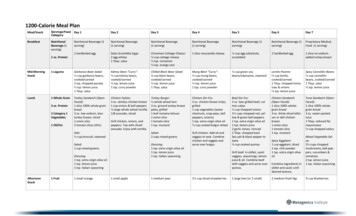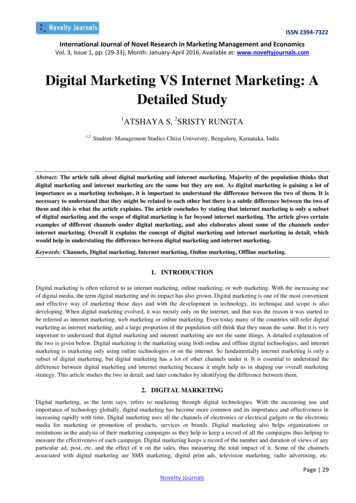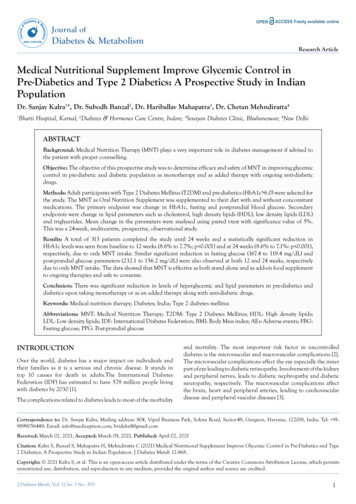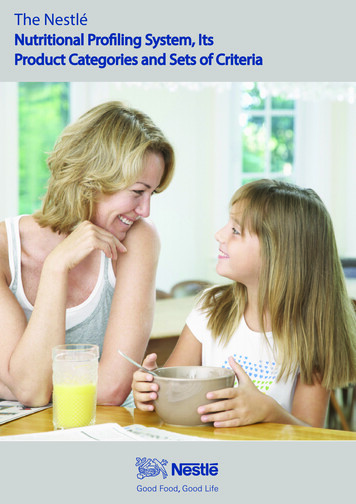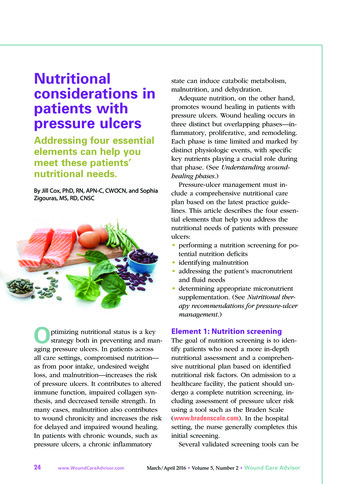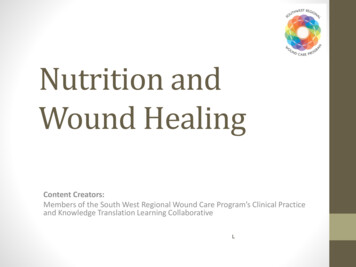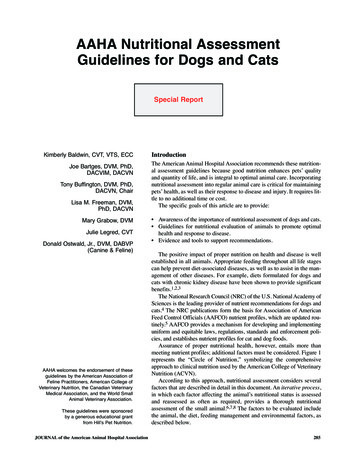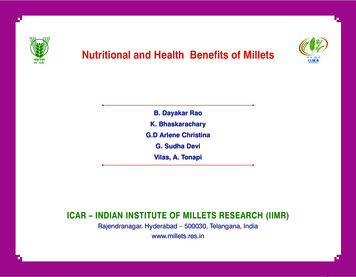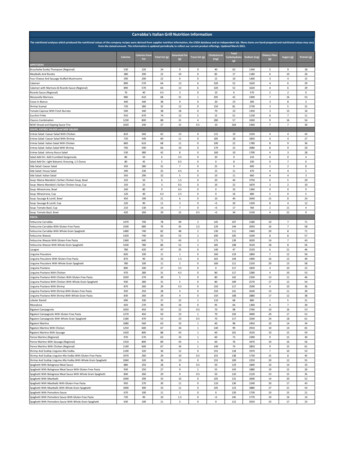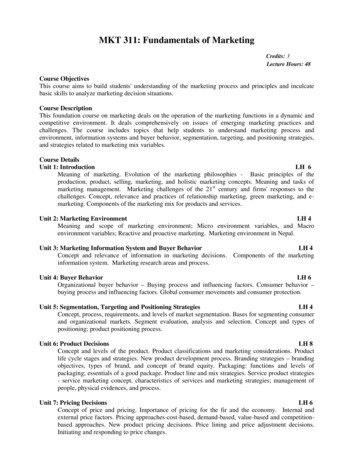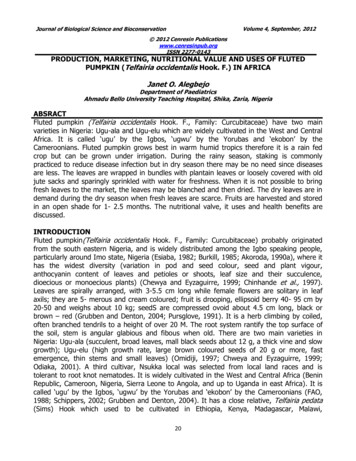
Transcription
Volume 4, September, 2012Journal of Biological Science and Bioconservation 2012 Cenresin Publicationswww.cenresinpub.orgISSN 2277-0143PRODUCTION, MARKETING, NUTRITIONAL VALUE AND USES OF FLUTEDPUMPKIN (Telfairia occidentalis Hook. F.) IN AFRICAJanet O. AlegbejoDepartment of PaediatricsAhmadu Bello University Teaching Hospital, Shika, Zaria, NigeriaABSRACTFluted pumpkin (Telfairia occidentalis Hook. F., Family: Curcubitaceae) have two mainvarieties in Nigeria: Ugu-ala and Ugu-elu which are widely cultivated in the West and CentralAfrica. It is called ‘ugu’ by the Igbos, ‘ugwu’ by the Yorubas and ‘ekobon’ by theCameroonians. Fluted pumpkin grows best in warm humid tropics therefore it is a rain fedcrop but can be grown under irrigation. During the rainy season, staking is commonlypracticed to reduce disease infection but in dry season there may be no need since diseasesare less. The leaves are wrapped in bundles with plantain leaves or loosely covered with oldjute sacks and sparingly sprinkled with water for freshness. When it is not possible to bringfresh leaves to the market, the leaves may be blanched and then dried. The dry leaves are indemand during the dry season when fresh leaves are scarce. Fruits are harvested and storedin an open shade for 1- 2.5 months. The nutritional valve, it uses and health benefits arediscussed.INTRODUCTIONFluted pumpkin(Telfairia occidentalis Hook. F., Family: Curcubitaceae) probably originatedfrom the south eastern Nigeria, and is widely distributed among the Igbo speaking people,particularly around Imo state, Nigeria (Esiaba, 1982; Burkill, 1985; Akoroda, 1990a), where ithas the widest diversity (variation in pod and seed colour, seed and plant vigour,anthocyanin content of leaves and petioles or shoots, leaf size and their succulence,dioecious or monoecious plants) (Chewya and Eyzaguirre, 1999; Chinhande et al., 1997).Leaves are spirally arranged, with 3-5.5 cm long while female flowers are solitary in leafaxils; they are 5- merous and cream coloured; fruit is drooping, ellipsoid berry 40- 95 cm by20-50 and weighs about 10 kg; seedS are compressed ovoid about 4.5 cm long, black orbrown – red (Grubben and Denton, 2004; Pursglove, 1991). It is a herb climbing by coiled,often branched tendrils to a height of over 20 M. The root system rantify the top surface ofthe soil, stem is angular glabious and fibous when old. There are two main varieties inNigeria: Ugu-ala (succulent, broad leaves, mall black seeds about 12 g, a thick vine and slowgrowth); Ugu-elu (high growth rate, large brown coloured seeds of 20 g or more, fastemergence, thin stems and small leaves) (Omidiji, 1997; Chweya and Eyzaguirre, 1999;Odiaka, 2001). A third cultivar, Nsukka local was selected from local land races and istolerant to root knot nematodes. It is widely cultivated in the West and Central Africa (BeninRepublic, Cameroon, Nigeria, Sierra Leone to Angola, and up to Uganda in east Africa). It iscalled ‘ugu’ by the Igbos, ‘ugwu’ by the Yorubas and ‘ekobon’ by the Cameroonians (FAO,1988; Schippers, 2002; Grubben and Denton, 2004). It has a close relative, Telfairia pedata(Sims) Hook which used to be cultivated in Ethiopia, Kenya, Madagascar, Malawi,20
Production, Marketing, Nutritional Value and Uses of Fluted Pumpkin(Telfairia occidentalis Hook. F.) in AfricaJanet O. AlegbejoMozambigue, Rwanda. Tanzania, Uganda, and Zanzibar (Chihande, et al., 1997; Schippers,2002).Ecology, Growth and DevelopmentFluted pumpkin grows best in warm humid tropics. It is a rain fed crop but can be grownunder irrigation (2-3 irrigations per week). It is a perennial but can be gown as an annualunder limited rainfalls. Seed size affects vigour and seedling germination (Grubben andDenton, 2004). Viability is about 63-89% and germination takes 7-14 days. Large seeds showgood growth potential (number of leaves, branches and uniformity of seedlings). Fruit growthis sigmoid over 8 weeks, but is rapid between 1.5- 5.5 weeks. Physiologically mature fruitsare obtained 9 weeks after fruit set.Production and ManagementDuring the rainy season, staking is commonly practiced to reduce disease infection. Plantsare staked individually or, for fruit production. During the dry season staking is not neededfor crops and for leaf production because there is less disease attack. Staking does not havea significant effect on the yield of leaves. Because of the prolific nature of the plant, weedsare not troublesome. Planting on flat land is the best method of weed suppression. Aboutthree weeding may be required in a staked crop during the rainy season. During the dryseason when plants are not staked, two weedings are needed before the leaf canopysuppresses most weeds. Mulching can be used as a method of weed control and to retain soilmoisture. The first pruning is 4 weeks after emergence to stimulate branching and increasethe growth. Irrigation is necessary for high leaf or fruit production especially under solecropping in the dry season. Watering is done once every 3 days. Organic manure or inorganicfertilizers are used in traditional systems, but for an optimal leaf yield the recommendedfertilizer application is 100 kg K2O and 50 kg P2O5 per ha. In southern Nigeria application of Pwas found to be especially important, as N and K only increased yields in combination withapplication of P. Female plants are more vigorous than male ones and produce highervegetative yields. (Grubben and Denton, 2004).HarvestingHarvesting begins about one month after emergence and is continued at 2-4 week intervalswhen new shoots are formed (depending on the cultivar, management practice, andenvironmental conditions) (Asiegbu, 1983). Harvesting is done by pruning with sharp knivesjust beneath the lowest acceptable leaf. Harvest interval has no effect on the life span of thecrop, as this depends on level of irrigation. Commercial production in Nigeria is fromNovember to July, with 20 or more harvests. Fruits (pods) are harvested 9 weeks after fruitset (Adetunji, 1997). Generally, female plants give higher yield than males ones (their leavesare larger, and vines are stronger, also they keep growing when flowers appear, which is notthe case for males). If planting is specifically for young shoots and leaves, early removal ofyoung flower buds is advantageous (Akoroda et al., 1989; Akoroda and Adejoro, 1990;Akoroda, 1990b). Fresh shoot yield could be as low as 500-1,000 kg/ha, but with goodmanagement, it could be as high as 3-10 t/ha (good irrigation, adequate fertilization). Seed21
Volume 4, September 2012Journal of Biological Science and Bioconservationyield could be up to 1.9 t/ha obtained from 3,000 fruits. The productive span is about 6-8months. The plants will sprout again when rains set in (Schippers, 2002).Processing and PreservationThe harvested succulent leaves can only remain fresh for one day. Leaves are harvested andpacked in jute bags. This may be stored in jute bags for up to 3 days in a well-ventilatedcondition. Larger bundles are wrapped with plantain leaves or loosely covered with old jutesacks and sparingly sprinkled with water for freshness (Asiegbu, 1983; Grubben and Denton,2004). When it is not possible to bring fresh leaves to the market, due to oversupply orbecause the farm is too far, the leaves may be blanched and then dried. The dry leaves arein demand during the dry season (October to January) when fresh leaves are scarce (Badifu,1993). Fruits are harvested and stored in an open shade for 1- 2.5 months. The fruits aregraded before being sold. Seeds are left in the fruits until they are used for planting orconsumed. Most of the fruits are transported by rail from the eastern to the middle belt andnorthern part of Nigeria. Collection and presentation of different fluted pumpkin accessions isbeing done in West and Central African Countries. Some level of varietal selection is takingplace in Nigeria and Cameroon (Odiaka, 2001; Grubben and Denton, 2004).MarketingFresh succulent leaves are preferred by consumers; hence traders transport their productover long distances prefer smaller and less succulent leaves that are less perishable. Theshoots are sorted out into lengths and tied into bundles. Care is taken to avoid breaking thestems. Large bundles are offered for whole sale, while the smaller bundles are sold as retail.The shoots are stored under the shade and water is sprinkled on it at intervals to keep itfresh. Watering is done minimally to avoid rotting of the leaves. The leaves are alsotransported by road from the south to the big cities in the northern Nigeria. Fruits are sold asmature or immature stage (about USS1.0-1.5) (Grubben and Denton, 2004). They are thesource of seed for planting. The immature fruit is sold for its unripe seed that is appreciatedas food. Fruits are found in all major markets in Nigeria and Cameroonduring the dry season(Odiaka, 2001). Most 0f the fruits are transported to the middle-belt or far north of Nigeria.NUTRITIONAL VALUETelfairia seeds and leaves have lots of nutritive value (Tables 1 and 2). These make theleaves potentially useful as food supplements (Oderinde et al., 1990). The moisture contentof the leaves show large variations and is a function of the cultivar plant age, environmentalfactors, and management practice.Table 1. Nutritive value of Telfairia seeds and leavesSeedWater (ml)6.0Calories543.0Protein (g)20.5Fat (g)45.022Leaves86.047.02.91.8
Janet O. AlegbejoProduction, Marketing, Nutritional Value and Uses of Fluted Pumpkin(Telfairia occidentalis Hook. F.) in AfricaCarbohydrates (g)Fibre (g)Calcium (mg)Phosphorus (mg)23.02.284.0572.07.01.70.00.0Source: FAO (1988)Table 2. Trace elements in Telfairia seed flour: mg/100 g wet samplePotassium (k)1824Magnesium (M)535Sodium (Na)280Source: Akintayo (1997)The young leaves contain the anti-nutrients cyanide at 60 mg/100 g dry matter and tanninsat 41 mg/100 g dry matter. The leaves contain adequate vitamins A and C. Mineral contentof the seed is fairly high. The seeds are high in essential amino acids (except lysine) and arecomparable with that of soybean meal with 95% biological value. The fruit pulp is about1.0% protein and the seed oil is made up of oleic acid (37%), stearic and palmitic acid (21%each), linoleic acid (15%).UsesThe leaves and seeds are used as vegetables. The tender leaves, succulent leaves andimmature seeds are cooked and consumed as vegetable. Leaves may be used alone ortogether with okra, dika nut (Irvingia sp.) or egusi seeds (Citrullus lanatus (Thunb.) Matsum.& Nakau. Sometimes they are mixed with 'eru' (Gnetum afvricanum Welw.) and Pterocarpussoyauxii Taub. They may also be cooked with fish, meat and tapioca, and are then eatenwith pounded yam, ‘eba’, ‘apu’ and ‘amala’ etc. These are favourites throughout Central andSouthern Nigeria (Grubben and Denton, 2004; Schippers, 2002). Sometimes male flowers arepicked for consumption together with the shoots and leaves. When the leaves are becomingcoarse, they are often mixed with other vegetables such as waterleaf (Talinum fruticosum).The immature seeds are shelled and the kernels are eaten boiled or roasted and used assnack. To ease seed shelling, the seeds are boiled for about 30-60 minutes. This is thenadded to the soup in ground form (Schippers, 2002). Mature seeds are first washed toremove the dye found in the cotyledon. They are less tasty, but are good sources of edibleoil. Ground seeds are used in making cakes which are high in protein and are suitable forfortifying foods, while the oil is served as cooking oil and for making margarine. The oil canalso be used as drying oil for paints and varnishes (Grubben and Denton, 2004). Pregnantwomen and patients suffering from anemia use the leaf juice to strengthen the blood. Otheruses include: stems are macerated to produce fibres that are used as sponge; the oily seedshave lactating properties and are therefore in high demand by women with young babies;the raw flour shows better water- and fat adsorption properties than the oil, hence it is usefulin baking and ground meat products; the rind and pulp of the fruit is used as fodder forlivestock.23
Volume 4, September 2012Journal of Biological Science and BioconservationHealth Benefits of Fluted PumpkinThe sliced young leaves mixed with coconut water and salt could be stored in a bottle andused for the treatment of convulsion (Gbile, 1986). Also the leaf extract alone is useful in themanagement of hyperchelsterolaemia, liver problems, and impaired immune system (Eseyinet al., 2005a; Adaramoye, 2007) but the oil from the seed could result in hyperlipidermiasand hyperglycaemia if consumed excessively. Protein Energy Malnutrition (PEM) is rarelyseen among the dwellers where Telfairia is consumed in large proportion daily (Dike, 2010).The use of T. occidentalis in reproductive and fertility is gaining ground. Nwangwa et al.(2007) showed that it has potential to regenerate testicular damage and increasespermatogenesis. Telfairia is high in anti- oxidant and free radical scavenger properties andthat may contribute to why many use the leave extract in oxidative damage condition such ascancers, liver and liver diseases. In Nigeria the fresh leaves are ground and the juice used astonic by women that have just given birth; its high iron content assists in the replenishmentof lost blood; being used for treatment of anaemia, chronic fatigue and diabetes (Alada,2010; Dina et al., 2006; Aderibigbe et al., 1999). The blood schizontocidal activity of the rootof Telfairia is comparable to that of chloroquine (Okokon et al., 2007). The extract alsoshows inhibitory effect on growth of some bacteria (Oboh et al., 2006; Odoemena andOnyeneke 1998; Oluwole et al., 2003). Telfairia roots are very poisonous because of theirhigh sapoin content and are used to kill rats and mice as rodentcide and ordeal poison (Gill,1992).Future Research NeedsCollection and identification of the various cultivars in the African continent is very essential;statistical data on total production in each country is inevitable; more information is neededon the uses of the crop in the traditional African societies, more study on the nutritive valueof the leaves and seeds of different fluted pumpkin cultivars will be very useful; moreresearch into the health benefits of the various parts of the crop is urgently neededespecially the study of phytochemicals in fluted pumpkin (from the seedling to theirconsumption, passing though the harvesting, storage and processing etc) to have a betterunderstanding of their mechanisms in human health.; breeding work on the crop is at itsrudimentary stage and needs upgraded; improved planting materials are needed to increaseits production. Collaborative research work between the Research Institutes and scientistsworking on the crop should be set up.REFERENCESAdaramoye, O. A., J. Achem, O.O. Akintayo and M.A. Fafunso. 2007. Hypolipidaemic effect ofTelfairia occidentalis (fluted pumpkin) in rat fed a cholesterol-rich diet. Journal ofMedicne and Food, 10: 330-336.AderIbigbe, A. O., B.A.S. Lawal., and J.O. Oluwagbemi. 1999. The antihyperglycaemic effectof Telfairia occidentalis. in mice. African Journal of Medicine Sci. 28: 171-175.24
Production, Marketing, Nutritional Value and Uses of Fluted Pumpkin(Telfairia occidentalis Hook. F.) in AfricaJanet O. AlegbejoAdetunji, I. A. 1997. Effect of time interval between pod set and harvesting on the maturityand seed quality of fluted pumpkin. Experimental Agriculture 33 (4): 449-457.Akintayo, E. T. 1997. Chemical composition and physical properties of fluted pumpkin seedand seed oils. Nigeria: Chemistry Department, Ondo State University (report).Akoroda, M. O. 1990. Ethnobatany of Telfairia occidentalis among Igbos of Nigeria. EconomicBotany 44 (1): 29-39.qAkoroda, M. O. 1990. Seed production and breeding potential of the fluted pumpkin.Euphytica 49 (1): 25-32.Akoroda, M. O. and M. A. Adejoro. 1990. Patterns of vegetative and sexual development ofTelfairia occidentalis. Tropical Agriculture 67 (3): 243-247.Akoroda, M. O., N. I. Ogbechie-Odiaka, M. I. Adebayo, O. E. Ugwo and B. Fuwa.1989.Flowering, pollination and fruiting in fluted pumpkin. Scientia Horticulturae43: 197-206.Alada, A.R.A. 2000. The haematologic effect of Telfairia occidentalis in diet preparation.Africa Journal of Biomedical Research, 3: 185-186.Asiegbu, J. E. 1983. Effects of method of harvest and interval between harvests on edibleleaf yield in fluted pumpkin. Scientia Horticulturae 21: 129-136.Badifu, G. I. O. and A. O. Ogunsua. 1991. Chemical composition of kernels of someCurcubitaceae grown in Nigeria. Plant Foods for Human Nutrition 41 (1): 35-44.Badifu, G.I.O.1993. Food potentials of some unconventional oilseeds grown in Nigeria: a briefreview. Plant Foods for Human Nutrition 43: (3): 211-224.Burkill, H. M. 1985. The useful plants of West Tropical Africa. Vol 1. Kew: Royal BotanicGardens.Chihande, D., F. Zinanga and J. van der Mheen. 1997. The role of indigenous vegetables inZimbabwe. Report for Community Development Trust, supported by IDRC,Canada.Chweya, J. A. and P. B. Eyzaguirre. 1999. The biodiversity of traditional leafy vegetables.Rome: IPGRI.25
Volume 4, September 2012Journal of Biological Science and BioconservationDike, M.C, 2010. Proximate phytochemical and nutrient compositions of some fruits, seedand leaves of some plant species at Umodike, Nigeria. ARPN Journal of Agricultureand Biological Science, 5:7-16.Dina O.A., A. A. Adedapo., O.A. Oyinloye and A.B. Saba. 2006. Effect of Telfairia occidentalis.extract on experimentally induced anaemia in domestic. African Journal ofBiomedical Research, 3: 181-188.Ejike, E.C.C., P.C. Ugboaja. and U.S. Ezeanyika. 2010. Dietary Incorporation of Boiled FlutedPumpkin () seed I: Growth and toxicology in Rats. Research Journal of BiologicalScience, 5(2): 140-145.Eseyin, O.A., A.C. Igboasoiyi., E. Oforah, P. Ching. and B. C. Okoli. 2005b. Effects of leafextract of Telfairia occidentalis on some biochemical parameters in rats. GlobalJournal of Pure and Applied Science, 11: 17-19.Eseyin, O.A., A.C. Igboasoiyi., E. Oforah, H. Mbagwu, E. Umoh. and J.F. Ekpe. 2005a. Studiesof the effect of alcohol extract of Telfairia occidentalis.on alloxan induced diabeticrats. Global Journal of Pure and Applied Science, 11: 85-87.Esiaba, R. O. 1982. Cultivating the fluted pumpkin in Nigeria. World crops 34 (2): 70-72.FAO. 1988. Traditional Food Plants. Rome: FAO.Gbile, Z.O., 1986. Ethno botany, Taxonomy and Conservation of Medicinal Plants In: Thestate of Medicinal Plants Research in Nigeria, Sofowora, A (Ed.). University ofIbadan Press, Ibadan, Nigeria.Gill, L.S. 1992. Ethromedical Uses of Plants in Nigeria. Uniben press, University of Benin,Benin City, Edo state Nigeria, pp 228-229.Grubben, G.J.H and Denton, O.A. 2004. Plant Resources of Tropical Africa 2 vegetables, p:668. PROTA Foundation, Wageningen, Netherlands Backhuys Publishers, Leiden,Netherlands/CTA, Wageningen Netherlands.Nwangwa, E.E J. Mordi, O. A. Ebeye, A. O and A.E Ojieh. 2007. Testicular regenerativeeffects induced by the extracts of Telfairia occidentalis in rats. Caderno depesquisa, series Biology, 19: 27-35.Oboh, G. E.E. Nwanna. and C. A. Elusiyan. 2006. Antioxidant and antimicrobial properties ofTelfairia occidentalis (fluted pumpkin) leaf extract. Journal of Pharmacology andToxicology, 1: 167-175.26
Production, Marketing, Nutritional Value and Uses of Fluted Pumpkin(Telfairia occidentalis Hook. F.) in AfricaJanet O. AlegbejoOderinde, R., O. Tairu, F. Awofala and D. Ayediran. 1990. A study of the chemicalcomposition of some Curcubitaceae family. Rivista Italiana delle Sostanza Grasse67 (5): 259-261.Odiaka, N. I. 2001. Survey on the production and supply of Telfairia ocidentalis in Makurdi,Benue Stat Nigeria. Crop Production Department, University of Agriculture Makurdi,Nigeria.Odoemena, C. S. and E. C. Onyeneke. 1998. Lipid of fluted pumpkin (Telfairia occidentalis)seeds. Proceedings of the 1st African Conference on Biochemistry of Lipids, (ACBL“98) Ambik Press, Benin City, Nigeria, pp147-151.Okokon, J.E., A. J. Ekpo. and O. A. Eseyin. 2007. Antiplasmodial activity of ethanolic tootextract of Telfairia occidentalis. Research Journal of Parasitology, 2: 94-98.Oluwole, F.S., A. O. Falode and O. O. Ogundipe. 2003. Anti inflammatory effect of somecommon Nigeria vegetables. Nigeria Journal of Physiological Science, 18: 35-38.Omidiji, M. O. 1977. Tropical cucurbitceous oil plants in Nigeria. Vegetables for the Hot,Humid Tropics 2: 37-39.Purseglove, J.W. (1991). Tropical crops: Dicotyledons. Longman Scientific and Technical Copublished in the United State with John Wiley and Sons.New YorkSchippers, R.R., 2002. African indigenous vegetables, an overview of the cultivated species2002. Revised edition on CD-ROM. National Resources International LimitedAylesford, United Kingdom.Williams, I.O., R.S. Parker. and J. Swanson, 2009. Vitamin A content of southeastern Nigeriavegetable dishes, their consumption pattern and contribution to vitamin Arequirement of pregnant women in Calabar urban, Nigeria. Pakistanian Journal ofNutrition, 8: 1000 – 1004.27
Ahmadu Bello University Teaching Hospital, Shika, Zaria, Nigeria ABSRACT Fluted pumpkin (Telfairia occidentalis Hook. F., Family: Curcubitaceae) have two main varieties in Nigeria: Ugu-ala and Ugu-elu which are widely cultivated in the West and Central Africa. It is called 'ugu' by the Igbos, 'ugwu' by the Yorubas and 'ekobon' by the
